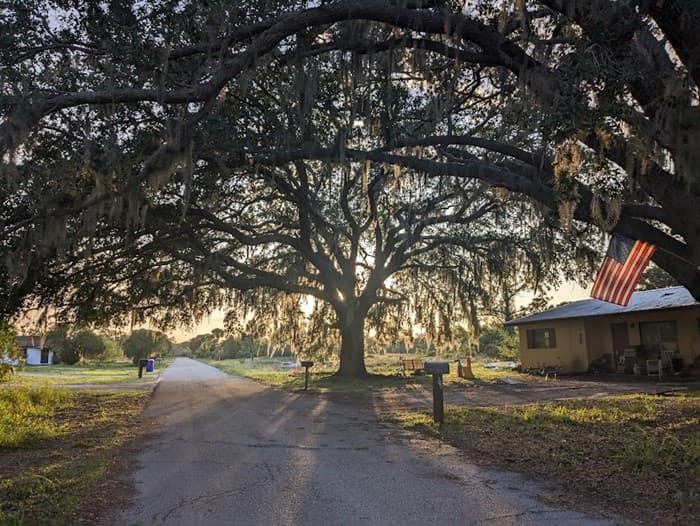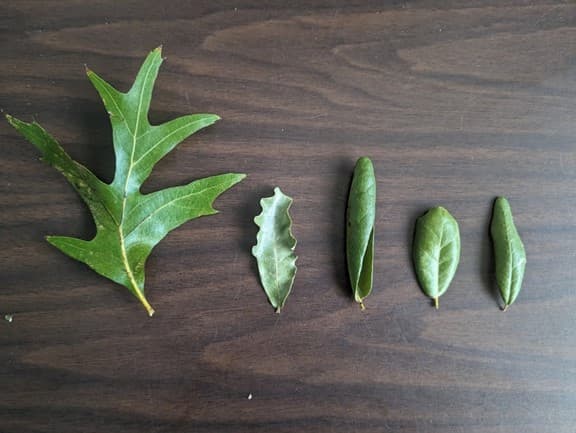 Photo by: Hannah Bowen
Photo by: Hannah BowenLocal Oaks for Local Folks
Author: Hannah Bowen
The expansive crown and large sweeping branches of mature Live Oak trees make them easy to recognize. Other than their distinct shape, what makes these mature Live Oak trees so memorable? Maybe it is the green carpets of Resurrection Ferns that sometimes occupy their bark, or the way the sunlight shines through the Spanish Moss that appears to be dripping off their branches. The attention this emblematic and majestic tree receives is well deserved, though let us not forget about the 12 other species of oak that are found right here in Highlands County.
“While mature Live Oaks (Quercus virginiana) may be easy for some to identify, a younger Live Oak can be easily mistaken for a Laurel Oak (Quercus laurifolia) or vice versa,” said Hannah Bowen, Research Assistant in the Plant Ecology Program at Archbold Biological Station. If you are having trouble differentiating between these two oaks that are commonly found in the yards, parks, and tree-lined streets of central Florida, check out their bark. “Laurel Oaks have comparatively much smoother bark than Live Oaks, which have dark narrow furrows that deepen as the tree ages,” Bowen continued.
“When we do vegetative surveys in the Scrub, we need to be able to tell the difference between up to six different oak species” Bowen shared. “It’s easy when we come across a Turkey Oak (Quercus laevis), named for its turkey foot shaped leaf, because their leaves have the classic oak lobes.” Yet, when it comes to telling the difference between other often overlooked shrubby oaks (figuratively and literally), the Plant Ecologists at Archbold need to take a closer look.
“In the field we joke that the Florida Scrub Oak (Quercus inopina) has taco shaped leaves, and that Myrtle Oaks (Quercus myrtifolia) have Tostito scoop chip shaped leaves, because the top of their rounded leaves sometimes folds under along the edges,” explained Hannah.
However, Myrtle Oaks (Quercus myrtifolia) don’t always have that Tostito scoop chip shaped leaf, as they can present a wide range of leaf shapes and can be easily confused with Chapman’s Oak (Q. chapmanii), whose leaves can also vary from lobed to un-lobed. So how do Archbold Plant Ecologists tell the difference between these quirky Quercus species? They look for other clues, like the presence of tiny hairs on the inside of mature acorn caps.
In Florida, there are two oak groups: Red Oaks and White Oaks. The Myrtle Oak belongs to the Red Oak group, and Chapman’s Oak belongs to the White Oak group. Among other differences, trees in the Red Oak group have tiny hairs on the inner surface of their acorn caps, whereas the acorns of trees in the White Oak group are smooth and hairless.
As acorn season approaches, keep your eye out for mature acorns. If are feeling curious, pop off the acorn cap and look for little hairs. You won’t be the only one looking for mature acorns- these nuts are a vital food source to Florida’s only endemic bird, the Florida Scrub-Jay. Do the jays know the difference between acorns from the red and white groups? Very likely! Acorns from the Red Oak group have a higher tannin content, making them less palatable to wildlife.
Check out the list below detailing all 13 species of Oaks in Highlands County by their scientific and common names, as well as the oak group they belong to. When deciphering between oak species, knowing which group a species belongs to is a great place to start!
White Oak group: Live Oak (Quercus virginiana), Sand Live Oak (Q. geminata), Chapman’s Oak (Q. chapmanii), Sand Post Oak (Q. margarettae),
Red Oak group: Laurel Oak (Quercus laurifolia), Darlington Oak (Q. hemisphaerica), Turkey Oak (Q. laevis), Florida Scrub Oak (Q. inopina), Myrtle Oak (Q. myrtifolia), Dwarf Live Oak (Q. minima), Water Oak (Q. nigra), Bluejack Oak (Q. incana), Running Oak (Q. pumila)
 Photo by: Hannah Bowen
Photo by: Hannah BowenLeaves of scrub oak species in order: Turkey Oak (Quercus laevis), Chapman’s Oak (Q. chapmanii), Scrub Oak (Q. inopina), Myrtle Oak (Q. myrtifolia), and Sand Live Oak (Q. geminata). Photo by Hanna Bowen.